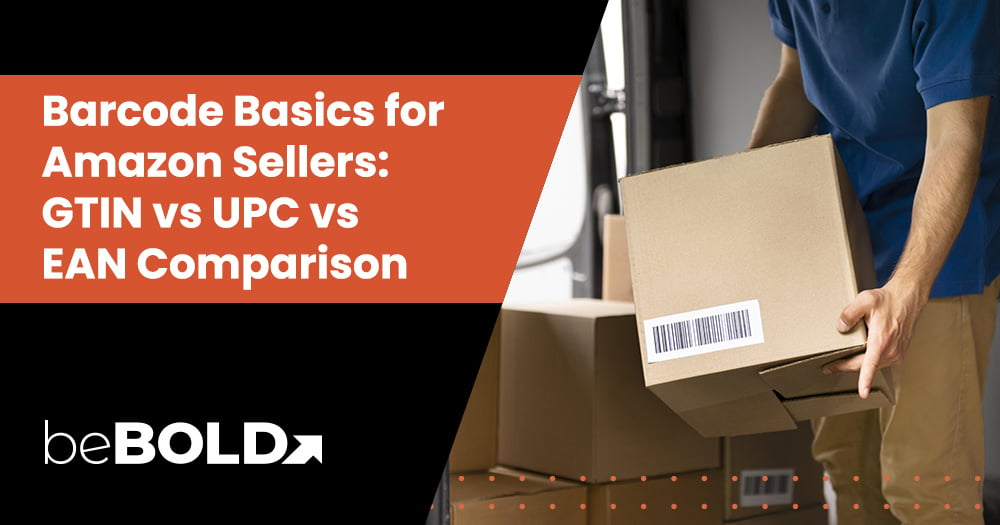Key Highlights
- GTINs, UPCs, and EANs are essential for accurate product identification, inventory management, and global trade.
- UPC (GTIN-12) is used in North America, while EAN (GTIN-13) is the global equivalent, ensuring seamless retail operations.
- Amazon assigns ASINs for internal tracking, but sellers still need a UPC, EAN, or GTIN for product listings.
- Having the right product identifier improves search visibility, prevents duplicate listings, and streamlines checkout experiences.
- Sellers without a GTIN can apply for an exemption, but branded products typically require a valid UPC or EAN.
- Understanding these identifiers helps businesses scale across multiple platforms while maintaining product authenticity and traceability.
Product identification is crucial in e-commerce and retail in today's digital marketplace. Barcodes and product identifiers like GTIN, UPC, and EAN serve as unique identifiers to help sellers track inventory, prevent duplicate listings, and ensure smooth store checkout experiences.
Understanding product identifiers is essential for Amazon sellers to list products successfully. Amazon requires a valid barcode (UPC, EAN, or GTIN) to maintain product integrity, prevent duplicates, and enhance discoverability for most products. However, with multiple barcode formats available, sellers often get confused about their differences and how they impact product listings.
This guide includes everything you need to know about GTINs, UPCs, and EANs, their importance, differences, and how they impact your Amazon sales strategy.
What are GTINs, UPCs, and EANs?
Product identifiers ensure that every product sold online or in retail stores has a unique identity. This prevents duplicate listings and ensures seamless tracking and sales management.
What is a GTIN (Global Trade Item Number)?

GTIN (Global Trade Item Number) is a globally recognized identifier system for retail products. It standardizes product identification across different markets and uses various barcode formats, including UPC and EAN.
GTIN Variants:
- GTIN-12: The 12-digit format used in North America (UPC).
- GTIN-13: The 13-digit format used globally (EAN).
- GTIN-14: The 14-digit format used for multi-unit packaging, such as cartons.
GTINs are registered through GS1, the global organization that manages product identification standards.
Understanding GTIN with a Real-World Example
GTIN (Global Trade Item Number) is a globally standardized system for identifying retail products. It ensures consistency across markets using different barcode formats like UPC (GTIN-12) and EAN (GTIN-13).
Let’s say Coca-Cola sells a 500ml bottle in different markets. The GTIN format changes depending on where and how the product is sold.
GTIN-12 (UPC) – Used in North America

A Coca-Cola 500ml bottle sold in the U.S. has a 12-digit UPC barcode:
012345678905
This code is scanned at checkout in American and Canadian stores to identify the product.
GTIN-13 (EAN) – Used Globally

The same bottle sold in Europe has a 13-digit EAN barcode:
5012345678906
The first digits (e.g., 50) indicate the country or manufacturer.
GTIN-14 – Used for Bulk Packaging

If a retailer orders a carton containing 12 Coca-Cola bottles, the carton gets a 14-digit GTIN-14 barcode:
15012345678902
This helps with inventory tracking in warehouses and bulk shipments.
What is a UPC (Universal Product Code)?

UPC is a 12-digit barcode format commonly used in North America at the point of sale (POS). It consists of:
- A company prefix assigned by GS1.
- A product identifier unique to each item.
- A check digit that validates the barcode.
Key Benefits of UPCs:
- Used in retail and online stores.
- Ensures fast and accurate scanning at checkouts.
- Helps businesses track inventory efficiently.
Example: Apple iPhone 15 (128GB, Black)
- A retailer selling an iPhone 15 (128GB, Black) in the U.S. assigns it a UPC: 194253420229
- This 12-digit number appears as a barcode on the product packaging.
- When scanned at a store or on Amazon, it ensures the right product is identified.
What is an EAN (European Article Number)?

EAN is the international version of UPC and is 13 digits long. It follows UPC's structure but includes an extra digit for expanded global use.
Why Use EANs?
- Used in over 100 countries outside North America.
- Accepted in both retail stores and e-commerce platforms.
- Helps in cross-border trade for businesses selling internationally.
Example:

Nike Air Max 270 (Men’s, Black/White, Size 10)
Let’s say a Nike Air Max 270 shoe is sold in Germany. It will have an EAN barcode like:
8712345678906
Breakdown of the EAN:
- Country Code (87) – Indicates the manufacturer’s country (e.g., Netherlands).
- Manufacturer Code (12345) – Identifies Nike as the brand.
- Product Code (67890) – Represents the specific Air Max 270 shoe model.
- Check Digit (6) – Ensures the barcode’s validity.
EANs and UPCs are interchangeable on most online platforms, including Amazon, as long as they are registered through GS1.
ASIN vs GTIN vs UPC: What’s the Difference?
Amazon assigns a unique ASIN (Amazon Standard Identification Number) to every product on its platform. However, an ASIN is not a substitute for GTINs or UPCs.
What is an ASIN (Amazon Standard Identification Number)?
An ASIN (Amazon Standard Identification Number) is a unique alphanumeric code that Amazon assigns to every product on its product detail page. Unlike UPCs and GTINs, which are universal identifiers used across multiple marketplaces, an ASIN is exclusive to Amazon.
- Every product listed on Amazon has a unique ASIN, which helps Amazon organize its catalog.
- If a product already exists on Amazon, new sellers listing the same product must use the existing ASIN rather than creating a new ISBN.
- ASINs help Amazon track inventory, sales, and product details across its marketplace.
Example:
Apple AirPods Pro (2nd Generation)
If you search for Apple AirPods Pro (2nd Gen) on Amazon US, you’ll find its ASIN:
ASIN: B0BDHWDR12

Where can you find the ASIN?
Product Detail Page – Scroll down to the "Product Information" section.
Amazon URL – Look at the web address of the product page
https://www.amazon.com/Apple-Generation-Cancelling-Transparency-Personalized/dp/B0BDHWDR12
![]()
The ASIN is always in the URL after /dp/
Here’s a detailed comparison table for ASIN vs. UPC vs. GTIN to help understand their differences:
|
Feature |
ASIN (Amazon Standard Identification Number) |
UPC (Universal Product Code) |
GTIN (Global Trade Item Number) |
|
Purpose: Each GTIN format serves a specific purpose, including an internal tracking number for Amazon products. |
Internal tracking number for Amazon products |
Global product barcode used in North America |
Global product identifier used worldwide |
|
Digits/Format |
10-character alphanumeric code |
12-digit numeric code |
Can be 8, 12, 13, or 14 digits |
|
Where It’s Used |
Only on Amazon |
Mostly in North America |
Used worldwide in retail and e-commerce |
|
Issued By |
Amazon |
GS1 (Global Standards 1) |
GS1 (Global Standards 1) |
|
Required for Listing? |
Only needed if selling on Amazon |
Required for selling in retail & Amazon (unless exempt) |
Mandatory for most marketplaces unless a GTIN exemption applies |
|
Replaces Other Identifiers? |
No, ASIN is assigned in addition to GTIN/UPC |
No, it's a subset of GTIN-12 |
No, GTIN is an umbrella term covering UPC, EAN, etc. |
|
Can Be Used on Other Platforms? |
No, exclusive to Amazon |
Yes, used by retailers, e-commerce, and logistics |
Yes, it is used for tracking products across global marketplaces |
|
Does It Help in Search Visibility? |
Yes, helps Amazon categorize products correctly. |
Yes, ensures accurate product identification. |
Yes, improves discoverability across marketplaces. |
|
Used for Inventory Tracking? |
Yes, but only within Amazon |
Yes, for warehouses and retail stores |
Yes, used in logistics, warehouses, and online platforms |
|
Commonly Used By |
Amazon sellers |
Retailers, brands, and online sellers |
Manufacturers, brands, and global sellers |
|
Can It Be Reused? |
No, unique per product listing |
No, each UPC is assigned to a specific product |
No, each GTIN uniquely identifies a product variety |
What Happens If You Don't Have a UPC or GTIN?
If you're launching a private-label product, handmade goods, or bundles, you may be eligible for a GTIN exemption on Amazon. However, a valid UPC or EAN is required to sell branded items.
How to Check If a Product Already Has an ASIN?
To find an existing ASIN for a product:
- Search for the product on Amazon.
- Scroll down to the Product Information section.
- Look for the ASIN field, which will display a 10-character code.
If no ASIN exists, you must create a new ASIN by listing the product with a valid UPC, EAN, or GTIN.
Comparison Chart: GTIN vs EAN vs UPC
|
Identifier |
Digits |
Region |
Purpose |
Issued By |
|
GTIN-12 (UPC) |
12 |
North America |
Retail and e-commerce |
GS1 |
|
GTIN-13 (EAN) |
13 |
International |
Retail and global sales |
GS1 |
|
GTIN-14 |
14 |
Worldwide |
Bulk product packaging |
GS1 |
Why Do Amazon Sellers Need Product Identifiers?

Amazon sellers find product identifiers such as GTIN, UPC, and EAN indispensable. They ensure accurate data capture and maintain product distinction, and they also contribute to smoother inventory management, fewer listing errors, and enhanced product visibility. A reliable barcode system allows Amazon sellers to sail smoothly in the volatile waters of e-commerce. Let's explore how these identifiers benefit the various aspects of Amazon's business.
Inventory Management
Barcodes help businesses track stock levels and organize product catalogs efficiently. Without proper identifiers, managing extensive inventories becomes difficult.
Avoiding Listing Errors
Amazon verifies UPCs and GTINs to prevent counterfeit or duplicate listings. Using an invalid barcode can result in Amazon listing suppression or removal.
Better Product Visibility
Amazon groups listings using product identifiers (GTINs) to ensure customers can find the correct products. Correct GTINs improve discoverability and search rankings.
Where to Purchase GTINs, UPCs, and EANs?
The international non-profit organization GS1 is your reliable source for procuring GTINs, UPCs, and EANs. They provide an easy process where you can purchase individual barcodes or multiple ones with a company prefix, depending on your requirements. However, an annual renewal fee exists to keep these barcodes active. Some agencies also partner with GS1 to make barcode purchases more straightforward. Always opt for registered barcodes when selling through retailers or e-commerce platforms.
How to Get an Exemption from GTINs from Amazon?
The process to get an exemption from GTIN is easy. Below we have added steps so please check it out.
Check if Your Product Needs a GTIN Exemption

- Go to Catalog > Add Products on your Amazon dashboard.
- Select Blank form and click Start.
Enter Product Details

- In the Product Identity tab, fill in the Item Name field.
- Amazon will auto-fill Product Type—click Confirm if correct or Select other to adjust.
Mark the Product as Exempt

- Complete the Item Type Keyword field.
- Tick This product does not have a brand name and I don’t have a Product ID.
Submit the Request
- If an exemption is needed, a pop-up will confirm GTIN/UPC exemption approval.
- Click Acknowledge to finalize.
Wait for Confirmation
- The exemption may take up to an hour to become effective.
Who Qualifies for a GTIN Exemption?
You can apply for a GTIN exemption if:
- You sell handmade, private-label, or custom products without manufacturer-assigned barcodes.
- Your product category does not require a barcode (e.g., books use ISBNs).
How to Apply for a GTIN Exemption?
- Go to Amazon Seller Central → Apply for GTIN Exemption.
- Select your product category and brand.
- Upload clear images of the product showing branding and packaging.
- Submit the request and wait for approval.
If granted, you can list products without a GTIN.
Common Myths About GTINs, UPCs, and EANs

There’s a lot of confusion surrounding product identifiers, especially for Amazon and e-commerce sellers. Below are some of the most common myths and the truth behind them.
Myth #1: I can use any UPC for my product
False. Amazon verifies all UPCs against the GS1 database. If your UPC is not GS1-registered, your listing could be flagged, suppressed, or removed. Always purchase UPCs directly from GS1 to avoid listing issues.
Myth #2: EAN and UPC are entirely different
Not true. The EAN (European Article Number) is simply the 13-digit international version of the UPC (12-digit Universal Product Code). While UPCs are commonly used in North America, EANs are widely accepted in Europe and globally.
Myth #3: GTINs aren’t necessary for selling on Amazon

Incorrect. Unless you qualify for a GTIN exemption, Amazon requires a valid GTIN (UPC, EAN, or ISBN) for product listings. This ensures product authenticity, prevents duplicates, and helps Amazon match products correctly.
Myth #4: I can reuse a GTIN for multiple products
A GTIN is unique to a specific product and variant, such as size, color, or model. Reusing a GTIN for different products can lead to listing errors, mismatched inventory, and possible account suspension.
Myth #5: Buying cheap UPCs from third-party sellers works just fine
Many third-party UPC resellers offer barcodes already assigned to other products, leading to conflicts in Amazon’s system. Only GS1-issued UPCs guarantee that your product has a unique, verified barcode.
Myth #6: GTINs only matter for Amazon sellers
Many e-commerce platforms and physical retailers require GTINs, including Walmart, eBay, Shopify, and significant retail stores. Proper GTINs are essential if you plan to expand your business.
Myth #7: If I’m a private-label seller, I don’t need GTINs
Some private-label brands qualify for a GTIN exemption, but Amazon still requires proof of brand ownership. If you don’t have an exemption, you must purchase GS1-registered GTINs.
Myth #8: Amazon assigns me an ASIN, so I don’t need a GTIN
ASINs (Amazon Standard Identification Numbers) are used internally on Amazon but don’t replace GTINs. A valid GTIN is usually required to create a new listing.
Myth #9: GTINs, UPCs, and EANs expire over time
GTINs are permanent once assigned to a product. However, if you stop renewing your GS1 account, GS1 may reassign your UPCs to another business.
Myth #10: If my product doesn’t have a barcode, I don’t need a GTIN
Even if your product is sold exclusively online and doesn’t have a physical barcode, e-commerce platforms still require GTINs for tracking and cataloging. If your product doesn’t have one, you may need to purchase a GTIN or apply for an exemption.
If you're unsure whether you need a GTIN or exemption, consult beBOLD Digital for expert guidance.
Best Practices for Using Barcodes in Amazon Listings

Adhere to some best practices to maximize the benefits of barcodes. These include ensuring barcode accuracy, utilizing registered barcodes, updating product identifiers for variations, and keeping current with the specific requirements of marketplaces such as Amazon. Implementing these strategies can enhance your listing efficiency and increase sales significantly.
1. Ensuring Barcode Accuracy

Consider these points to ensure your barcode accuracy:
- Data Integrity: Make sure the numbers and symbols used in creating the barcode are accurate and align with the data intended to be encoded.
- Barcode Symbology: Always use the correct barcode symbology as determined by the type of data you want to encode.
- Barcode Readers: Validate the printed barcode using barcode readers or scanners to ensure it accurately represents the correct information.
2. Updating Product Identifiers for Variations

Product variation is common in the ever-changing market scenario. It's crucial to note this and ensure that product identifiers are updated accordingly. Each unique variant must have an identifying mark that sets it apart from its kin. Tracking such changes and updating the identifiers helps maintain accuracy and foster customer trust in the listings.
Hiring an Amazon Agency to Handle Product Listings

Managing product identifiers like GTINs, UPCs, and EANs can be overwhelming, especially for new sellers. Ensuring compliance with Amazon’s guidelines, securing GS1-registered barcodes, and maintaining accurate listings require time and expertise. This is where professional Amazon agencies can make a difference.
If you’re looking for a trusted partner to handle your Amazon business product listings, beBOLD Digital offers expert solutions tailored to your needs. By working with beBOLD Digital, you can focus on growing your brand while experts handle the complexities of selling on Amazon.
Whether you're launching a new product or need help optimizing your listings, the team ensures that your business stays competitive in the ever-evolving e-commerce landscape. Contact us NOW.
Conclusion
Managing barcodes and product identifiers can be complex, but a clear understanding of pricing is key. Whether using GTINs, UPCs, EANs, or ASINs, having a uniform system is crucial for managing product listings effectively. Understanding these identifiers streamlines processes like inventory management and boosts product visibility. Utilizing GS1's barcodes or professional assistance can simplify the process. While daunting at first, mastering these codes is worth the effort for smoother retail and e-commerce operations.
Frequently Asked Questions
What is the difference between GTIN, UPC, and EAN?
Though all three are product identifiers, their usage varies. While GTIN is a global identification key, UPC is a 12-digit GTIN primarily used in North America, and EAN is a 13-digit GTIN mainly used outside North America.
Do I need a GTIN to sell on Amazon?
Yes, Amazon generally requires a GTIN for each product listed. However, under certain circumstances and based on the product type, there may be exceptions, and you can apply for a GTIN exemption.
How can I get an exemption from GTINs?
You might qualify for a GTIN exemption if your product falls under specific categories, such as handmade or vintage items. However, the procedure for obtaining this varies and depends on the platform's policies.
Can I use an EAN instead of a UPC on Amazon?
Yes, both EAN and UPC are accepted on Amazon. Despite their regional specificities, they are part of GS1’s universally recognized and readable international standards.
Stay ahead in e-commerce—book a call with us now for expert optimization!









Comments